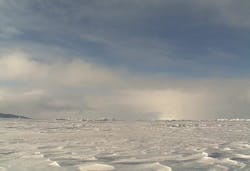Rochester, NY--A collaboration between the Rochester Institute of Technology (RIT) and the University of Buffalo (Buffalo, NY) is aimed at improving the interpretation of satellite-based lidar (light detection and ranging) data used to monitor changes in the earth's polar ice.
John Kerekes at RIT won a three-year, $561,130 grant from NASA to help the space agency's scientists better create 3D renderings or digital elevation maps that scientists can use to measure changes in the polar ice. Future NASA missions, such as the upcoming Ice, Cloud and land Elevation Satellite-2, or ICESat-2, will use lidar devices. Slated for launch in 2016, ICESat-2 will measure ice-surface topography and assess changes to Greenland and Antarctic ice sheets and sea ice.
"The ICESat-2 science team wants to be able to measure annual changes in ice-sheet thickness to within a few millimeters, averaged over the entire ice sheet," says Kerekes. He explains that real ice sheets and glaciers have narrow crevasses that may be only a few meters wide and tens of meters deep; lidar pulses will interact with that complex surface in a way that will be very different than if it were just a flat surface.
Kerekes' team will give lidar a trial run in a simulated arctic environment well before NASA launches the technology on its future mission. They will use the Digital Imaging and Remote Sensing Image Generation tool, developed at RIT, to model the light-scattering radiometric behavior of the Earth and its atmosphere in a computer-coded world of glaciers and icebergs orbited by a simulated ICESat-2.
"DIRSIG is capable of simulating scenes that reflect the physics and radiometry found in the real world as compared to simulations that were designed for a movie, where it doesn't have to have the right physical units; it just has to look good," Kerekes says.
Input from geophysicist Beata Csatho at the University at Buffalo will provide essential details; her expertise in polar topics with a remote-sensing perspective will layer the scenes with realistic physical details of ice sheets and glaciers, lending relevance to tests of the laser sensor's signal processing methods via computer software.
"Ice sheets and outlet glaciers often change rapidly exhibiting a complex pattern, controlled by interactions with climate, oceanographic and geological processes," says Csatho. "Simulations will allow us to develop and test algorithms to process ICESat-2 data for mapping the surface as accurately as possible, even in adverse conditions such when blowing snow or ice fog restrict the visibility or the lidar beam is reflected from a surface covered by melting snow or large snow crystals."
Kerekes and Csatho will attend an ICESat-2 Science Definition Team meeting in Washington, D.C., in January to meet with other scientists involved with the data analysis.
About the Author
John Wallace
Senior Technical Editor (1998-2022)
John Wallace was with Laser Focus World for nearly 25 years, retiring in late June 2022. He obtained a bachelor's degree in mechanical engineering and physics at Rutgers University and a master's in optical engineering at the University of Rochester. Before becoming an editor, John worked as an engineer at RCA, Exxon, Eastman Kodak, and GCA Corporation.

